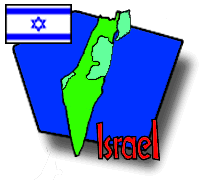

(29/1/98) When you visit Jaffa you walk through quaint, winding, cobblestone alleyways lined with old buildings and walls made out of a honey brown colored stone, full of tiny holes, like air bubbles, where the sea can trickle in, called "Kurkar", taken from the sand dune, hardened over the millions of years of its existence, where its built and which gives it its high vantage point overlooking the small harbor, which is one of the most ancient in the world, you think you're in ancient Jaffa, but you're not.
You're in an Arab, Mamaluke sea side town of the 14th century, destroyed by Napoleon Bonaparte in 1799 and reconstructed in 1966, Ancient Jaffa goes back to the 3rd Millennium before Christ, and was built and destroyed more than 20 times in its long history, its ruins today form the scenic hill known as the "Tell" Jaffa.
This grassy hill, which stands in the center of "modern day Jaffa" (19th Cen.) is a great place for picnickers and has a spectacular view over the Mediterranean and the modern city of Tel Aviv.(20th Cen.).
While you sit there munching your sandwiches, made with fresh bread from Abulafia, the famous bakery nearby, open day and night, you not only have plenty of food to eat but quite a bit of food for thought aswell. For example, you might ponder on why the Gospels place Peter's vision of the sheet with the unclean animals in Jaffa and not anywhere else. In all humility I offer my answer to this question in the hope that it will enlighten without conflicting with the answers given by traditional Biblical commentators.
Being a coastal city, and the safest harbor on the Eastern Mediterranean coast in Biblical times, Jaffa was, like all the other coastal cities, such as Ashdod, Ashkelon, Gaza, more open to Pagan influence than the cities of the interior; Jerusalem, Bethlehem, Nazareth Cana etc. The coastal cities were inhabited, successively, throughout history by the Canaanites, Philistines and the Greeks, seafaring nations from the Mediterranean basin, who had settled here at various periods in history and had brought with them religious customs and eating habits completely opposed to the laws of the Torah of the Israelites. I'm sure that Pork and shell fish, forbidden in the Torah to be eaten, were popular amongst those nations. These laws of the Torah make it impossible for Peter, a Jew to have a meal with the Pagan inhabitants of Jaffa. Not eating with them creates a social barrier between Peter and the Pagans, the people to whom he is supposed to bring the message of the Gospels. The vision he has permits what the Torah had forbidden, namely to eat the flesh of unclean animals and so eat and socialize with the Pagans, making it possible for him to preach the Gospel and convert them to Christianity.
![]() Check out some of Leon's photos
Check out some of Leon's photos
Leon Gork (Tour Guide)
P.O.Box 4354 Jerusalem 91042
Tel/Fax 02 5810732....Cel.053 801867/823905
e-mail.leongork@netvision.net.il
Treasurer:Jerusalem for Bicycles
 |
 |
 |
 |
 |
|
Itinerary/ Journal |
Discussions |
About Israel |
eDscape Projects |
Scrapbook |
|
|
|
|
|
|
|
Copyright 1997-2004 BikeAbout. Text copyright 1998 Leon Gork (used by permission). All rights reserved.